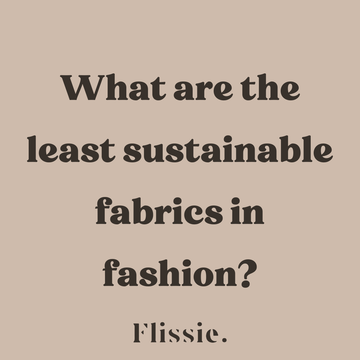If you have been wondering about the least sustainable fabrics in fashion, I'm going to tell you; there are a lot of fabrics that are bad for the environment. If you're interested in finding out the fabrics to avoid so you can shop more sustainably and wear clothing that is better for the environment then this blog is for you.
At the end of this blog post, I will be suggesting some more sustainable alternatives so that you can choose wisely when shopping at your local store or online.
First, let's look at the least sustainable fabrics and why they're so bad for the environment.
- Conventional cotton is one of the most pesticide-intensive crops in the world. It also uses a lot of water and takes a long time to grow. Studies show that traditional cotton farming is responsible for up to 25% of the world's insecticide use and 11% of the world's pesticides.
- Polyester is one of the most common fabrics you will see in fast fashion. It is bad because it is made from petrochemicals, which creates toxic air and water pollution. In addition to this, it takes a lot of energy to produce polyester and it doesn't biodegrade so it ends up in landfills where it will sit for centuries.
- Acrylic is another synthetic fabric that you should avoid if you want to do your bit for sustainable fashion. The worst thing about acrylic fabric is that it is made from non-renewable resources and it is a water hog. This is another non-biodegradable culprit. Watch out landfill!
- Nylon. This is one you should avoid if you want to be more sustainable in your fashion choices. Nylon is created through an industrial process that releases toxic fumes into the air. Environmental studies show that nylon production can be responsible for the release of up to 39 toxic chemicals.
- Rayon is indeed made from plants, but it's a controversial one because it's been marketed as sustainable however it's not necessarily eco-friendly because of its toxic production and the deforestation associated with it. Solvents used during this production process can be very toxic to humans and the environment.
Now you know what to avoid, let's look at some earth-loving fabrics to try out.
Our favourite sustainable fabric to keep an eye out for is Tanboocel® bamboo fibre because it is a renewable resource that grows quickly with little water and has other functions like moisture absorption, breathability, softness, deodorisation and it's antibacterial.
Tencel® lyocell fibre is made from sustainably sourced wood pulp and it's biodegradable so it makes a good option.
Hemp fibre is also a great choice as it requires no pesticides or fertilisers to grow and it's one of the most durable natural textile fibres.
There you have it, the least sustainable fabrics in fashion and some alternatives to try out. We hope this blog has helped you make more informed decisions when shopping for your next piece of clothing.
Thank you for reading!
Flissie xx

